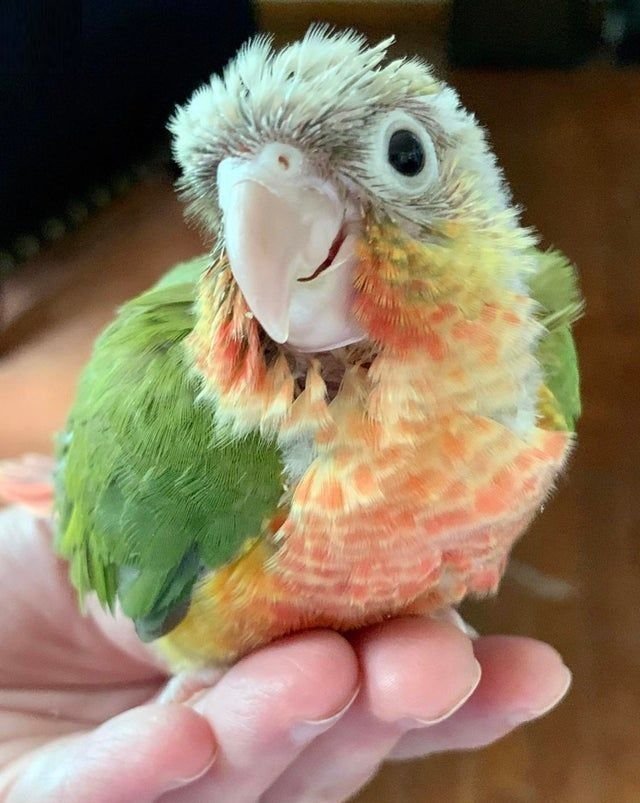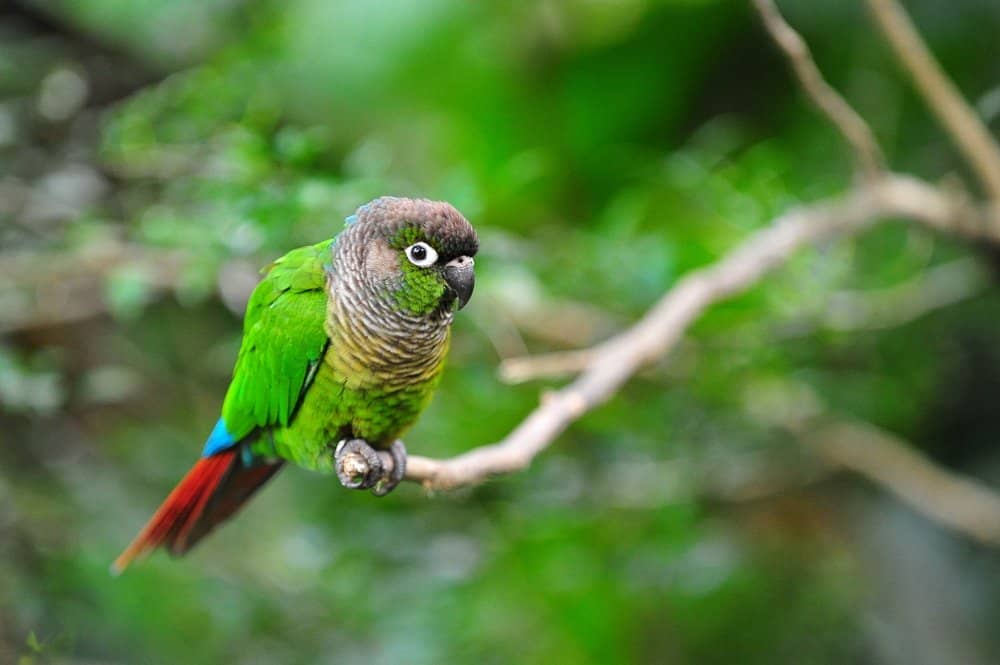
Green Cheek Conures or Green-Cheeked Conures are full of personality. They are one of the friendliest pet birds out there. They are affectionate, intelligent, easy to train, and understand many words and human gestures.
These birds are originally from South America and are often mistaken for Maroon-Bellied Conure cousins. Although they look kind of similar, if you look a little closer, Green-Cheeked Conures are actually brighter.
They also have a gray barring on their chest unlike the golden barring on the Maroon-Bellied ones.
They grow up to 10 inches from head to tail and they are not hard to take care of. If all goes well, they can live up to 25 years or more.
Green Cheek Conure Price
Green Cheek Conures, on average, cost $150 to $350. Some breeders may also sell them for as much as over $700 — not so cheap for a small bird.
There are a handful of breeders already across the US. Chicks and older conures are usually cheaper. However, newly weaned ones around 8-9 weeks are the ones with the highest price.
Once you buy one, it’s hard to know if it’s male or female. As such, if the breeder cannot provide the information too, you may want to get a DNA Gender Determination test at the nearest veterinarian near you.
Bird sexing may be done through blood or feather samples. Blood samples cost $17 to $19 per sample while feather samples cost $21 to $23 at DDC Veterinary in Ohio.
Some offer the same test for lower prices – as low as $12. Both tests provide accurate results.
Habitat
The next thing to think about after getting yourself a Green-cheeked conure is where to put it. It needs enough space to fly around. They will also need climbing areas.
The minimum size for a conure cage would be 18 x 22 x 24 inches with metal bars spaced ½ – ¾ inches. When it comes to the cage, the bigger, the better.
You may want to consider this one by Prevue. It costs like the conure too – $300 to $400, but you can choose among 9 colors. This is perfect for those who are particular with matching the cage to the interiors of their homes.
There’s also this Giantex Bird Cage Large Play Top Parrot Finch Cage. It’s a cheaper alternative—less than $150.
Green Cheek Conures can survive alone or with a parent or a pair. If they are bred, they lay 4-6 eggs.
They can also be with same-size conures even if they are not the Green-cheeked variety. Just make sure they do not breed if that’s the case. And make sure they are similar in size or else the bigger one might attack the other.
Also, it is best to put play areas for your birds. Rope perches are ideal.
Make sure you choose soft materials for your bird’s feet. They cost less than $30. Windy City Parrot in Chicago offers a large one—96 inches, priced at $26.

Diet
Green Cheek Conures are primarily herbivores. They need a diet of pellets, fresh vegetables, and fruit as well as seeds. They also eat insects and their larva, fish or meat sometimes.
When choosing dry food or pellets, make sure they are organic or all natural. Leafeber has a classic mix for small birds amounting to $6 for 8 ounces.
It also offers fruit mixes costing less than $10. Its Fruit Delight kind is less than $7 for 8 ounces while the Tropical Fruit variety is around $9 for 10 ounces.
However, some organic or all-natural mixes, like Leafeber, may still include sulphurated dried ingredients. You can always opt to buy seed and nut mixes that are processed for humans. Even baby food with fruits and vegetables is okay.
Their diets should also be high in calcium and vitamins (especially K and A) to avoid health complications. Dark leafy vegetables like kale, spinach, and lettuce are very good for them.
Your conures will also need fresh, dried or dehydrated fruits. Just make sure that no coloring or other artificial ingredients especially sulfur oxide were added. Also, do not feed your birds fruit pits.
Seeds should be included in your bird’s diet too but in controlled amounts. Too much seeds may lead to a high-fat diet which in turn, leads to a number of complications.
According to VCA Hospitals, seeds for birds are like candy for a child. They like to have a lot, but it leads to malnutrition.
You can also sprout your seeds for added nutrition. Other protein sources such as cottage cheese, hard-boiled eggs, and monkey chow should also be available. A hanging cuttlebone, mineral block or oyster shell should also be in the cage.
Make sure to vary the fruits and vegetables you provide regularly. If they do not like, say for example, carrots, today, that does not mean they won’t like it next week. Just make sure to vary the food you give like how it is in the wild.
It is also important to note that seeds and pellets should be in separate bowls.
Fresh water should also be present at all times. Most of the time water gets dirty because your birds like to play in it. Hence, you should always keep a watch. Make sure water is clean and chlorine-free daily.
Health
To keep your green cheeks healthy, provide them with the right nutrition. Also, allow them to bathe every other day. Put a bowl of fresh water every other day so they can clean themselves.
They also need to be treated for possible worms every three months if they are outside the house or every 6 months if they are kept inside. But do not treat them on very hot or rainy days.
Also, do not worm mothers. A good worm out gel is from Vetafarm. A 50ml pump bottle costs around $17.
Treatments are added to their water. Make sure that there are no other water source or fruits available during treatment. If there are other water sources, your birds will not take the medicated water.
Like humans, some birds may hate the smell and taste of treated liquids. VetaFarm Australia suggests you put a small amount of orange juice to mask the taste and make it a little sweeter.
It also suggests making the treatment available for two days. But a new mixture should be placed every day to avoid other complications.
Conures also need to be sprayed with treatments against mites and lice. This should be done every three months. Ultracare has one at around $8. per 8-oz bottle.
To avoid injury among your birds, make sure their nails are regularly trimmed. Some also suggest clipping their flight feathers. You should consult your veterinarian to know what’s best for your bird.
Red flags to be wary of is feather picking, back swelling, soiled or fluffed feathers, wheezing or coughing, runny or discolored stools, using only one foot while awake, eye or nasal discharge, red or swollen eyes, and the loss of appetite.
If you see these signs, it is best to go the nearest veterinarian to know for sure. Conures are prone to a number of diseases and these signs may be symptoms. A trip to the vet can cost anywhere from $30 to $80 depending on location while emergency cases can cost from $100 or more.
Conures are vulnerable to proventricular dilatation disease, psittacine beak and feather disease, psittacosis, beak malocclusion, aspergillosis, chlamydiosis, diarrhea, and the polyomavirus.
To avoid these complications, make sure to provide your birds with a well-balanced highly nutritious diet and a clean habitat.
